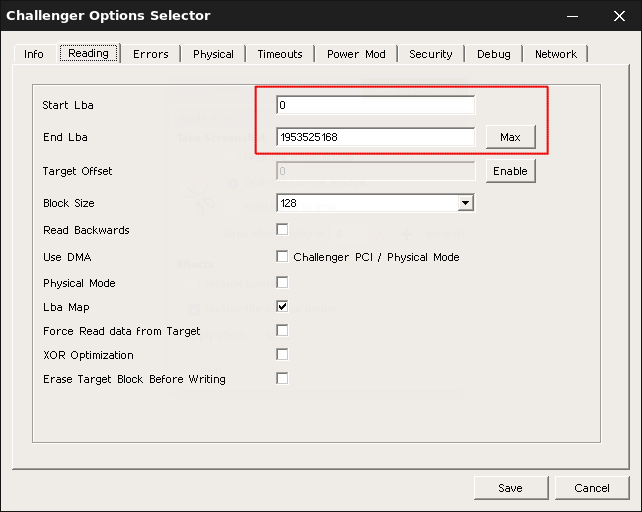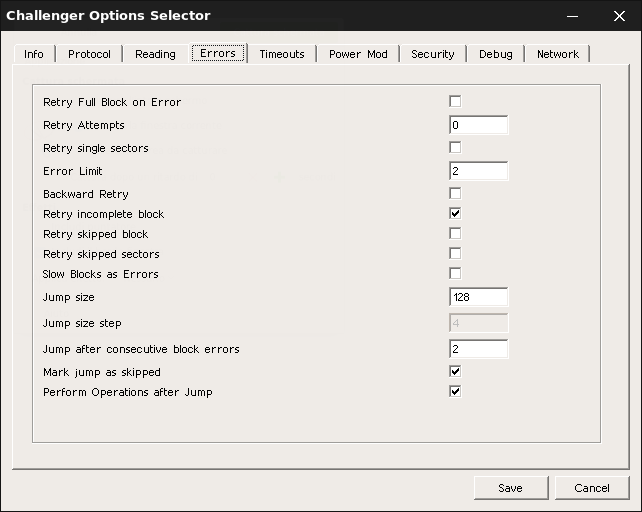Challenger Rocket Task Options¶
Options Window will be available in any Rocket Task Instance.
Challenger Rocket Options Window give user the chance to take full control of Reading Task process.
Option Selector has several pages :
- Info
- Protocol
- Reading
- Errors
- Timeouts
- Power Mod
- Security
- Debug
- Network
Info Tab¶
The Info Tab gives you general information about current task.
- current task path
- readed sectors
- readed bytes
- source device information
- target device information

Caution
Use info panel to check source device and target before starting any task.
Protocol Tab¶

Challenger Rocket offers 4 Possible Reading Methods:
- Posix
- CDB Packet SATA
- CDB packet SCSI
- Physical Mode ( Challenger PCI Board )
Posix¶
Posix Reading is the standard Linux Reading Protocol.
Queue and cache will be enabled, and Source Device will be Readed at the best possible performance.
Note
Posix Reading Mode should be selected in all cases where Disk Device works with no errors.
CDB Packet SATA¶
CDB Packet SATA Protocol is a passthrought command method.
The CDB Packet is a special packet sent to device avoiding use of che cache and queues.
In case of any damaged block or error the retry routines and recover methods will be handled by Rocket Reading Algorhitm.
Note
CDB Packet Reading Mode should be selected in all cases where Disk Device has been detected by operating system and does exist errors and delays.
CDB Packet SCSI¶
CDB Packet SCSI Protocol is a passthrought command method.
The CDB Packet SCSI is a special packet sent to device using SCSI Protocol.
CDB Packet SCSI SHOULD BE SELECTED for all SCSI SAS USB Disk Devices.
SCSI Sector size¶
SCSI Sector size parameter should be selected when device has a sector size different than standard 512 bytes per sector.
Note
Devices with sector size different than 512 bytes per sector are usually SCSI/SAS devices handled by IBM Operating system like AS400 or iSeries Systems.
Physical Mode¶
Physical Mode is a passthrought command method used for Challenger PCI Board Control.
Physical Mode option will be enabled only with Challenger PCI Board devices.
Challenger PCI Board connected devices will not be detected by Operating System but only from Challenger Rocket itself.
Physical Mode should be used in all cases of severe damage or really slow device response.
Note
in Physical Mode default selected Reading Protocol will be PIO. Enable DMA Flag in Protocol Tab from Options Window for a faster reading process.
Direct Memory Access (DMA)¶
DMA Protocol flag enables the PCI Board Busmaster increasing reading speed up to 55 MB/s.
Note
Challenger Rocket will switch from PIO to DMA and from DMA to PIO automatically calculating current drive health status.
Software Reset on Error (SRST)¶
Software Reset is a Special Reset command sent to device CTRL bus address.
It will be needed in all cases of BUSY bit on Device status Register to get drive ready to accept commands.
Software Reset Delay¶
Damaged Devices will answer to Software Reset with different times.
Software Reset Delay will give to Device more time to exit from a busy state after SRST Command.
Recalibration on Error (RECAL)¶
Recalibration is a command sent to device CMD bus address.
Reading Tab¶
The Reading Tab controls the Reading Range of current Task , the direction and the reading block.
Reading Tab parameters are expressed as LBA ( Logical Block Address ) values.
Hint
Default 128 LBA Block Size means 64KB with a sector size of 512 bytes per sector.
Changing Block Size will affect reading and writing performances.
Note
LBA value in bytes will be controlled by Protocol Tab Sector Size.

Start Lba¶
Start Lba Value is the Sector where task process will start from.
Start Lba Parameter will interest any Challenger Rocket Task, except from File Recovery Threads.
Start Lba Parameter will influence :
- Reading / Imaging / Cloning / Erasing
- Hex View Search Functions
- Data Carving Operations
- Search Partition Tasks
Note
In Challenger Rocket Backwards Mode, the start lba value will be the task ending sector .
End Lba¶
End Lba Value is the Sector where task process will stop.
When you insert a Different value than the Device max Address ( default lba ) reading process will stop
Start Lba Parameter will interest any Challenger Rocket Task, except from File Recovery Threads.
Start Lba Parameter will influence :
- Reading / Imaging / Cloning / Erasing
- Hex View Search Functions
- Data Carving Operations
- Search Partition Tasks
Target Offset¶
In a cloning or imaging task all source sectors will be transferred by default on target device ( clone or image ) at the same offset.
If you need to transfer sectors to target with a different offset, enable Target Offset and set the offset value.
Hint
Target Offset Feature will be useful to clone a Logical Partition in selective mode.
Block Size¶
Block Size Value is the Sectors Range Requested to Device for Each Reading command.
Changing Block Size will affect all Task Features ,Reading and writing behaviour.
Hint
Change Block Size to Restrict Skipped Blocks on a damaged device.
Refer to Chapter Using Block Size on Damaged Devices.
Note
In Challenger Rocket File System Mode, the requested block size could be different if needed sectors block will be smaller than Task Block Size.
Errors Tab¶
The Errors Tab gives you control to Error handling Algorithm.
Using Error Control Properly will reduce damaged devices stress and catastrophic failures events.

Retry Full Block On Error¶
Most of Reading Commands are sent in Block Mode ( more sectors requests for each command )
If a block reading Fails,BLock Read Command Can Be Retried more times.
In Most Block Error Cases this Option will result unuseful, since A damaged Block Response means single sectors errors.
Hint
Setting Retry Single Sectors will Solve and Discover Internal BLock Error.
Retry Single Sectors¶
If a Reading Block Command fails, setting option Retry Single Sectors will give you the chance to split the requested block in single sectors.
Setting Error Limit Value will limit the amount of error for each damaged block.
Backward Retry¶
If Retry Single Sectors options is set Backward Retry will perform reading of single sectors of the block in reversed mode.
In many cases this will help you to increase reading results.
Retry Incomplete Block¶
Setting Retry Incomplete Block will give Rocket the chance to enter into all partially readed blocks.
Retry Skipped Block¶
Setting Retry Skipped Block will give Rocket the chance to retry into a full skipped block.
Retry Skipped Sectors¶
Setting Retry Skipped Sectors will give Rocket the chance to retry skipped sectors into a block retry process.
Slow BLocks as Errors¶
Rocket Analyzes in real Time Device Performances.
On some cases a device slow down will lead into a critical zone.
Setting Option Slow BLocks as Errors will mark a slow block as damaged one and skipping and jumping operations will be Faster.
Jump Size¶
Jump Size value is essential while reading a damaged device.
If Rocket Finds a damaged Block, the consecutive damaged block counter will increase.
If consecutive damaged block Jump Value is Reached, Current Lba will be increased by jump size.
Skipped Area, can be flagged as skipped setting option Mark Jump As Skipped.
Perform Operations After Jump¶
If consecutive damaged block Jump Value is Reached and a jump is performed, Rocket can Perform a backward retry to isolate damaged area.
This will increase Recovery results Dramaticaly.
Hint
Setting Perform Operations After Jump will help you to Discover how many sectors are hosted by a sensor in Device Head Failures Cases.
Timeouts Tab¶
The Timeouts Tab controls Timeouts and Delays while sending command to device.
Slow Block Timeout¶
Slow Block Timeout Value is the delay tolerance of a sent command.
If Slow BLocks as Errors is set, and Slow Block Timeout is reached, current block will be handled as skipped block.
Command Delay¶
Command Delay Value is a delay applied after each read command.
This Delay Type could be useful on slow responding devices.
Block Error Delay¶
Block Error Delay Value is a delay applied after each failed block command.
This Delay Type is useful on busy responding devices or in physical mode after a bus reset command.
LBA Error Delay¶
LBA Error Delay Value is a delay applied after each failed single LBA command.
This Delay Type is useful on busy responding devices or in physical mode after a bus reset command.
Poweroff Time¶
On Challenger Rocket Systems with Power Mod Switch, PowerOFF Time value is the time left to Power Mod Before Re-Power device.
Using Error Control Properly will reduce damaged devices stress and catastrophic failures events.
